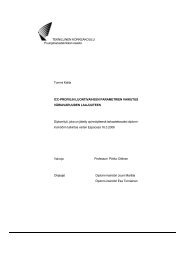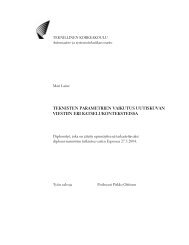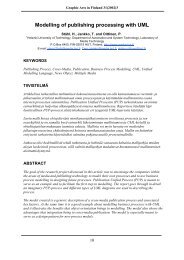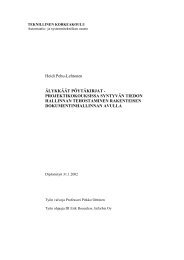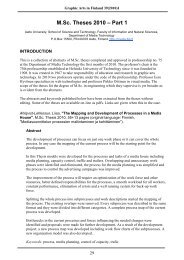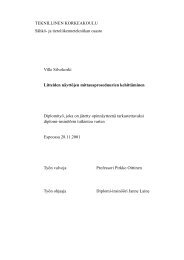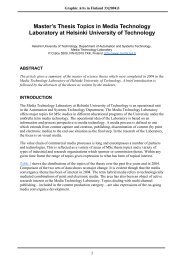By us<strong>in</strong>g a client-side storage mechanism, most of the aforementioned disadvantagescan be overcome. Figure 2 illustrates the modern <strong>in</strong>teraction model, which <strong>in</strong>cludesa client-side storage. First, a web page checks whether the client-side storagealready has the requested new data. If yes, then the data is immediately displayed onthe user <strong>in</strong>terface without communicat<strong>in</strong>g with the server. Otherwise, the requestednew data is retrieved from a database resid<strong>in</strong>g on the server, and when retrieved, thedata is stored <strong>in</strong> a client-side storage for future use. This approach not only makeswebsites faster, but it also enables offl<strong>in</strong>e support and reduces server load.Figure 2. Modern <strong>in</strong>teraction model.HTTP cookie [3] was the first mechanism, which enabled web applications to storedata on web clients. However, cookies do not meet the requirements of modern webapplications. Thus, new client-side storage mechanisms were needed. First came(Google) Gears [7], and then <strong>in</strong>fluenced by it, emerged various W3C-specified APIproposals [10, 11, 17]. Other useful and closely related W3C-specifications <strong>in</strong>cludefull Offl<strong>in</strong>e <strong>Web</strong> <strong>Applications</strong> [9], File API [19], and <strong>Web</strong> Workers [12]. However,these specifications are out of the scope of this paper.The rest of the paper is organized as follows. Section 2 exam<strong>in</strong>es very briefly thehistory of client-side storage. In Section 3, recently specified W3C API proposals forstor<strong>in</strong>g and manipulat<strong>in</strong>g persistent data on the client side are presented <strong>in</strong> detail. Nextsection <strong>in</strong>troduces research projects, which utilize these modern client-side storagemechanisms. F<strong>in</strong>ally, conclusions are drawn <strong>in</strong> Section 5.2 EvolutionThis section presents the evolution of legacy client-side storage mechanisms. Thesection starts by giv<strong>in</strong>g a very brief overview of the three popular storage mechanisms:HTTP cookie [3], Flash cookie [2], and (Google) Gears [7]. In the end, thefeatures of these three mechanisms are compared aga<strong>in</strong>st a set of evaluation criteria <strong>in</strong>order to highlight the similarities and differences of each mechanism.2
2.1 HTTP CookieHTTP cookie 1 [3], <strong>in</strong>vented by Netscape <strong>in</strong> 1994 and later standardized by IETF, isa popular mechanism that lets web servers and web clients to ma<strong>in</strong>ta<strong>in</strong> and manage astateful session between each other over the mostly stateless HTTP protocol. Cookiesallow a small piece of simple key-value pair data (4 kB per cookie, 50 cookies perorig<strong>in</strong>) to be stored <strong>in</strong> a user’s web client (browser). Cookie data can be set to lastover a s<strong>in</strong>gle session (session cookie) or multiple sessions (persistent cookie). Typically,web applications use them for session management, authentication purposes,stor<strong>in</strong>g user preferences, and user track<strong>in</strong>g. All major browsers have native supportfor cookies.Although cookies provide a simple and well-supported stor<strong>in</strong>g mechanism, theysuffer from several problems. First, each cookie is sent back and forth with everyHTTP request (via HTTP headers), which adds a lot of unnecessary overhead. Second,their storage size is way too small for modern web applications. Third, the sameweb application us<strong>in</strong>g cookies cannot be run <strong>in</strong> multiple web browser tabs simultaneously.F<strong>in</strong>ally, the API is a bit clunky. [15, 16]2.2 Flash CookieIn 2002, Adobe <strong>in</strong>troduced a feature called Flash cookie (Local Shared Object) [2],which is an Adobe Flash Player based mechanism to store and manage data on auser’s computer. Flash cookies are exactly like HTTP cookies, except that they canstore more complex data types than just pla<strong>in</strong> str<strong>in</strong>gs and offer more storage space(defaults to 100 kB per orig<strong>in</strong>). The easiest way to access Flash cookies fromJavaScript is via the ExternalInterface object, which was <strong>in</strong>troduced <strong>in</strong> Adobe Flash 8<strong>in</strong> 2006.In order to use Flash cookies, Adobe Flash Player 6+ plug-<strong>in</strong> needs to be <strong>in</strong>stalledto a web browser. Mobile browsers, however, are gradually mov<strong>in</strong>g away from Flash,and therefore the use of Flash cookies is no longer an option on mobile devices [1].2.3 (Google) GearsIn 2007, Google launched Gears 2 [7] which offers web applications, among otherfeatures, the ability to store and manage persistent data locally on web clients, andaccess to it through the use of a JavaScript API and a variant of SQL. Gears comeswith an embedded client-side relational database based on SQLite 3 . Compared toprevious solutions, Gears’ ma<strong>in</strong> advantage is its unlimited storage size.In March 2011, Gears announced that there will be no new Gears releases <strong>in</strong> the futureand newer browser versions will not be supported [8]. The decision was based onshift<strong>in</strong>g the focus from Gears to HTML5, i.e., to help the W3C <strong>in</strong> def<strong>in</strong><strong>in</strong>g and stan-1 Also referred to as a cookie, <strong>Web</strong> cookie, and browser cookie.2 Formerly Google Gears3 SQLite, http://www.sqlite.org/3



